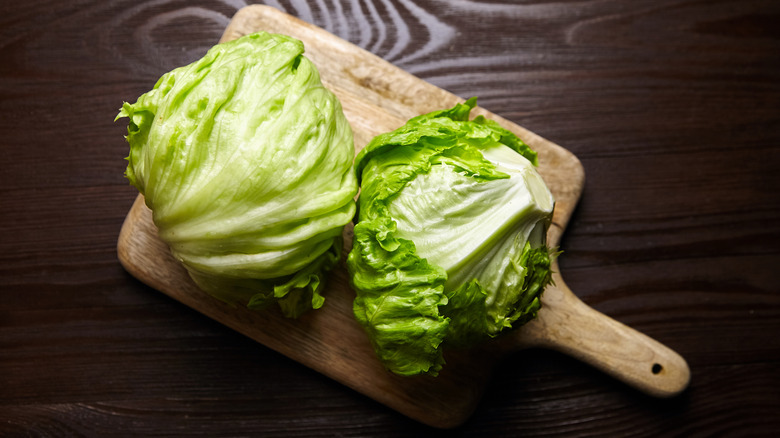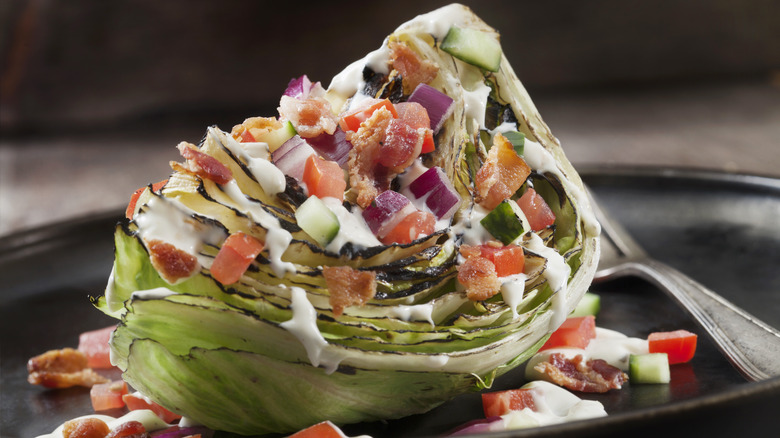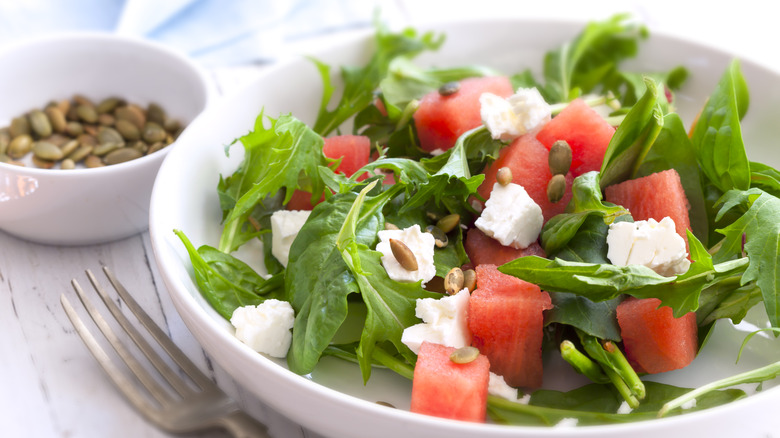Choose Iceberg Lettuce For An Ultra-Hydrating Salad Base
As the weather gets warmer, hands will be reaching for juices, smoothies, fruits, and colorful water infusions to quench thirsty bodies and boost hydration. But one of the most underrated ways to up your water intake is, in fact, to eat it. Not only is a salad an easy way to pack nutrients into a single meal, but it's also an especially hydrating dish when iceberg lettuce serves as the base.
It is impossible to miss the refreshing crunch of biting into a fresh piece of iceberg lettuce. Unfortunately, though, it often loses out to other greens like kale, spinach, romaine lettuce, and cabbage due to its more demure, neutral flavor. Of course, this is not such a bad thing if you do not care for these earthier, more bitter greens. Especially considering that, compared to its counterparts, iceberg lettuce has the highest water content. Bar cucumber, no other salad ingredient — and more generally, no other vegetable — contains as much water.
Iceberg lettuce does more than hydrate
The first thing about incorporating iceberg lettuce as your salad base is to know that bagged lettuce is never worth buying at the grocery store. Buying a fresh head of iceberg lettuce gives you more bang for your buck, and you get to avoid the risk of microbial contamination that is associated with bagged greens. You may have some sandy bits to deal with, but after washing it, give it a whirl in a salad spinner or fold a couple of paper towels into it, and then you can put it away in the best spot in your refrigerator to store a salad. This will maintain its crunch.
Although darker, leafy greens like kale, romaine lettuce, and spinach's nutrient profiles feature higher levels of things like fiber, this does not mean iceberg lettuce can't give your salad a boost in other ways. It is an excellent source of vitamins like A, K, and folate. Better still, using iceberg lettuce as a salad base means you can layer a range of other nutrient-dense foods into it, and use it to make something delicious and thirst-quenching.
Tips for the most hydrating salads
Unlike other greens, 96% of iceberg lettuce is water, romaine lettuce follows closely with a 95% water content — while spinach and cabbage contain 92% water. But to really boost the hydrating benefit of your lunchtime salad, you can use iceberg lettuce with some of these greens as well as a range of other hydrating vegetables that will add texture, flavor, and color along with all that water.
For instance, celery and radishes are also made up of 95% water; tomatoes, zucchini, and summer squash have a 94% water content while asparagus, bell peppers, cauliflower, and mushrooms all contain 92% water too. This means you can skip less hydrating salad ingredients like croutons and dehydrating foods like potassium-heavy beets and salty pickles. Potassium can act like a diuretic while salty foods draw out water from our cells.
Another way to make your salad a hydrating powerhouse is to add some water-heavy fruits. Watermelon, strawberries, and kiwis have at least 90% water — while peaches and grapefruits have an 89% and 88% water content, respectively. In fact, you could blitz your fruit together and make a sweet, tangy dressing for your salad.



